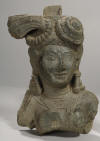|
saLT |
the-south-asian Life & Times July - September 2009 |
|
|||
|
Cover
Story Current
Affairs
|
|
||||
|
Swat’s Buddhist Legacy – a melting pot of cultures Text and photocourtesy Martin-Gropius-Bau, Berlin T o the Western viewer the Buddhist art of Gandhara seems strangely familiar; its rootedness in Western traditions is strikingly obvious. Gandhara is the name of a region in present-day Northwest Pakistan and Afghanistan whose connection with the West can be traced back to the far-flung conquests of Alexander (330 BC) and his local successors. Alexander’s foray laid the foundation for the trade along the Silk Road between the Roman Empire and the Far East and southern Asia. The Silk Road was also instrumental in the spread of Buddhism beyond its native India.Swat, a district in Pakistan’s North West Frontier Province, 160kms northwest of Islamabad, was once a part of Gandhara, a historical region (1st to 5th century AD) in present-day northwest Pakistan and Afghanistan. Its centre was the basin around the present-day city of Peshawar (known in ancient times as Purushapur). Gandharan culture, however, radiated far beyond this heartland all the way to Bamiyan in Afghanistan in the northwest and into the Punjab. The earliest mention of Gandhara appears in the tenth book of the Rigveda (ca 2nd century BC), a sacred ancient Indian text, and also the oldest surviving literary work. The recorded history of Gandhara goes back to 6th century BC, when it was a province of King Darius I of Persia. It then came under the Greeks in 4th century BC, who ceded it to the Maurya kings, and it thus became a part of the Indo-Greek kingdom until the arrival of the Kushan kings in the 1st century AD, who had been driven away from their Central Asian ancestral lands. The secular traditions of Gandhara were initiated by the Kushans, who supported all religious faiths. Predominantly Zoroastrian, they also worshipped Oesho and a number of other deities. Their support of Buddhism in Gandhara led to an unparalleled flourishing of Buddhist culture. A great many of the concepts that were to characterise Mahayana Buddhism were developed in Gandhara, and the Buddha himself was first represented during the Kushan period. The deification of the Buddha and the concept of the role of the bodhisattva – originally a person striving for enlightenment – can be documented very early on in Gandharan Buddhist art, which was a unique mix of highly diverse cultural and religious influences.
|
|||||
|
Copyright © 2000 - 2009 [the-south-asian.com]. Intellectual Property. All rights reserved. |
|||||
